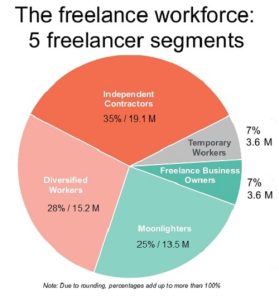The concept of employees as “lifers” is about as quaint as VHS training videos.
 While much is made of employees’ tendency to job hop, that trend takes a back seat to the bigger force in HR — the rise of freelancing. In fact, 35% of the total U.S. workforce now freelances, according to the 2016 Freelancing in America study commissioned by Upwork and Freelancer’s Union.
While much is made of employees’ tendency to job hop, that trend takes a back seat to the bigger force in HR — the rise of freelancing. In fact, 35% of the total U.S. workforce now freelances, according to the 2016 Freelancing in America study commissioned by Upwork and Freelancer’s Union.
And according to the Future Workforce Report, 62% of HR managers use some type of flexible worker (freelancers, temporary and / or agency workers).
This new model will continue to expand — nearly 80% of HR managers expect their department to use as many or more flexible workers this year.
That’s why today, HR sits at a pivot point with a more strategic seat at the table for business decisions. Now is the time for us to be agents of change across the organization to help our teams adapt to the changing nature of work.
Here are three areas where HR can have the most impact:
1. Provide value to the C-suite by talking in bottom-line terms
Traditionally, HR has gauged its success with metrics such as engagement and retention levels. Today, HR needs to demonstrate value by speaking the language of business: time and money.
HR has historically owned employment while contingent labor fell under procurement’s domain. But this separation between the traditional and flexible workforce limits an organization’s ability to effectively source the best talent for business needs while optimizing costs.
Better insight into the total talent picture allows HR to more effectively understand the skills that are available and what’s still needed. With full visibility into the total talent supply, HR is able to make better informed decisions about human capital investment.
Streamlining your talent acquisition process to include both full-time and contingent labor helps ensure that you’re finding and sourcing the best talent for each project need, while increasing speed and efficiency.
2. Encourage divisions to embrace new talent models
Research shows that freelancers can help companies grow and create opportunities that would otherwise not exist; in fact, 84% of hiring managers said they would have been forced to delay, cancel or extend project workloads if they hadn’t brought in a freelancer.
While project managers and leaders focus on accomplishing aggressive goals, HR can support them by filling their talent needs.
We offer our colleagues a massive advantage when we underscore the immediacy of a freelancer’s contributions — cutting the time to contribution to 12 days on average versus 29 days for employees, according to our research.
When HR innovates and drives the people strategy, we allow functional teams to focus on what they do best.
3. Facilitate an agile workforce
Ever wanted to be a Hollywood producer? Well in many companies that’s what the HR role is becoming. That’s because today’s workplace often resembles a movie set: A cadre of best-in-class professionals who come together to knock a project out of the park. Once it’s over, they all move on; they might find themselves working in smaller subsets on a similar project in the future, or they might never work together again.
When HR helps bring these teams together, we start to see the threads among all these connections and learn which talent has complementary skills. Maybe you find a web designer who brings a graphic designer she respects. All of a sudden you’re doubling value to your team because that duo is already primed for success.
Driving tomorrow’s talent strategies
Expanding our view of HR allows us to apply a more holistic lens to our talent acquisition strategies. When we are open to this broader definition of talent supply, we convey to our colleagues and C-suite that we can support them and the bottom line with the right resource at the right time.
R&D is no longer the main source of innovation across your company. Now is the time to assert our place at the table to be drivers of innovation and change. By strategically leveraging a flexible workforce to increase capacity and fill critical skills gaps, HR is powering businesses to expand and grow into new markets.
